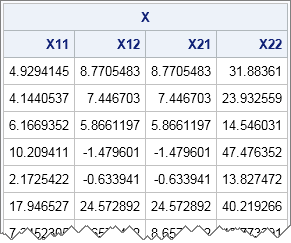All Posts

*** We interrupt discussion of James H. Lorie's 1957 article with this important announcement *** Hot off the wire, here is editor Len Tashman's preview of the Winter 2015 issue of Foresight: Foresight kicks off its 10th year with the publication of a new survey of business forecasters: Improving Forecast Quality in

SAS Global Forum brings together the most die-hard SAS users, both veteran and novice, once a year. It’s one of those can’t-miss events, and each year it just gets better. 2015 will bring us all together in Dallas, Texas for several days of active learning and excitement from SAS users
In this blog series, I am exploring if it’s wise to crowdsource data improvement, and if the power of the crowd can enable organizations to incorporate better enterprise data quality practices. In Part 1, I provided a high-level definition of crowdsourcing and explained that while it can be applied to a wide range of projects

Have you ever sprinkled sugar over your salad? Probably not, but as it turns out food companies have already done it for you! Dressings can have up to a whopping 2 teaspoons of sugar in just 2 tablespoons- that’s 1/3 of your recommended sugar for the entire day. Wouldn’t you rather
.@philsimon on the reliability of social numbers.

Brilliant, humorous, and obscure. Those words could describe two of my favorite comedians, Emo Philips* and the late Dennis Wolfberg. They could also describe, with the addition of "exceedingly" brilliant, "scathingly" humorous, and "apparently totally" obscure, a 1957 article, "Two Important Problems in Sales Forecasting" by James H. Lorie (The

We’re all about numbers here at SAS. So when the Global Certification program hit its 75,000th credential – we had to make it a big deal. We tracked down the 75,000th credential holder to Susan Langan, a research analyst in Maryland, and what’s even more special than Langan holding the
Once in a while, people run into an issue with the data that doesn't really need to be fixed right to ensure success of a specific project. So, the data issues are put into production and forgotten. Everyone always says, “We will go back and correct this later.” But that

The SAS DATA step supports multidimensional arrays. However, matrices in SAS/IML are like mathematical matrices: they are always two dimensional. In simulation studies you might need to generate and store thousands of matrices for a later statistical analysis of their properties. How can you accomplish that unless you can create

Suppose someone needs a kidney transplant and a family member is willing to donate one. If the donor and recipient are incompatible (because of blood types, tissue mismatch, and so on), the transplant cannot happen. Now suppose two donor-recipient pairs A and B are in this situation, but donor A

According to a 2012 report, it was estimated that over the next five years the US Internal Revenue Service (IRS) will issue more than $20 billion in potentially fraudulent tax refunds. Figures like this do little to boost taxpayers’ confidence in our nation’s tax system. And tax fraud is not

I'm ramping up my visualization skills in preparation for the next big election, and I invite you to do the same! Let's start by plotting some county-level election data on a map... To get you into the spirit of elections, here's a picture of my friend Sara's dad, when he was

Because finding analytical talent continues to be a challenge for most, here I offer tips 5, 6, and 7 of my ten tips for finding data scientists, based on best practices at SAS and illustrated with some of our own “unicorns.” You can read my first blog post for why they
Regulatory compliance is a principal driver for data quality and data governance initiatives in many organisations right now, particularly in the banking sector. It is interesting to observe how many financial institutions immediately demand longer timeframes to help get their 'house in order' in preparation for each directive. To the

Part 1 of this topic presented a simple Sudoku solver. By treating Sudoku as an exact cover problem, the algorithm efficiently found solutions to simple Sudoku problems using basic logic. Unfortunately, the simple solver fails when presented with more difficult Sudoku problems. The puzzle on the right was obtained from













